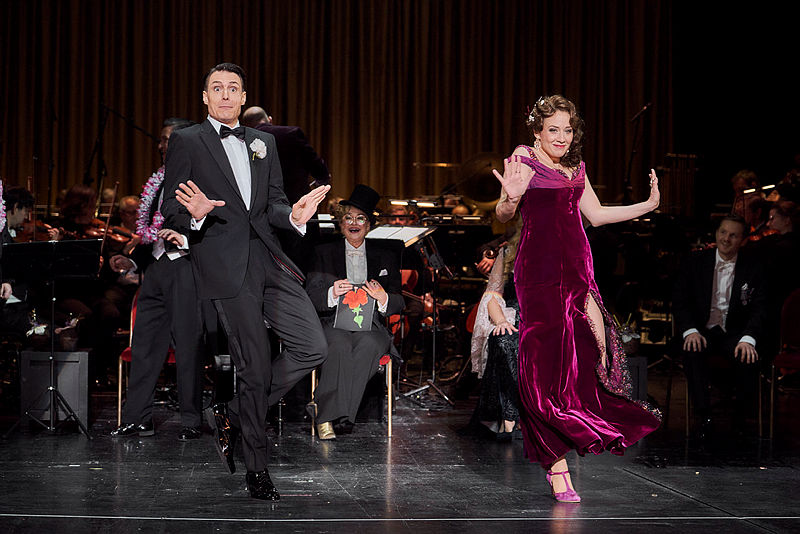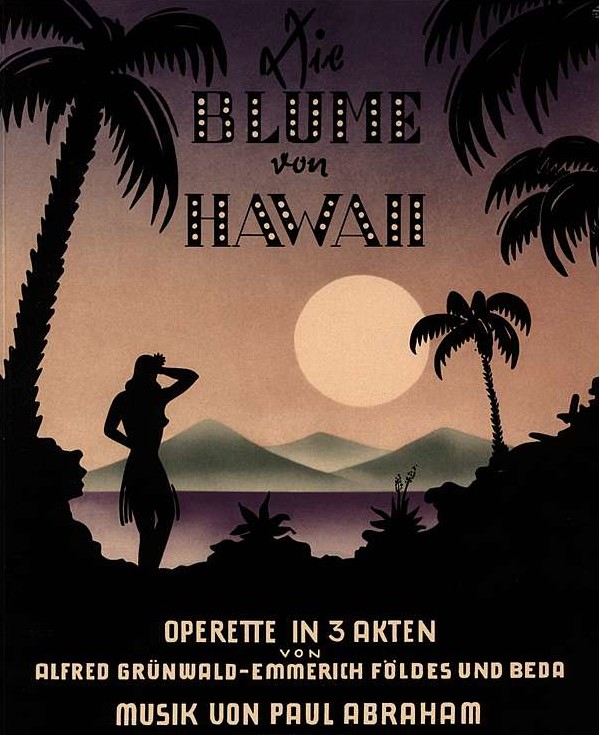Kevin Clarke
Operetta Research Center
21 December, 2021
It’s the end of an era. For ten years Barrie Kosky made it his mission to revive forgotten Weimar Republic operettas that the Nazis tried to erase from memory (and the repertoire). One of the corner stones of his revival crusade were the so called Christmas Operetta Concerts – five were dedicated to Emmerich Kalman and his lesser known shows, including a truly amazing Arizona Lady with the one-and-only Katharine Mehrling and the equally singular Serkan Kaya. Kalman was followed by five Paul Abraham operettas, the last one now being Blume von Hawaii. There will be one more performance on 30 December, and a radio broadcast on the 31st.

Jörn-Felix Alt as Joker Jim (l.) and Alma Sadé as Princess Laya in “Blume von Hawaii” at Komische Oper Berlin. (Photo: Jaro Suffner)
When the Christmas operettas started, no one at Komische Oper knew whether people would come. So only a single performance was scheduled. But the audience reaction was so overwhelming, and the demand for tickets so great, that the company soon added a second performance after Christmas. According to Barrie Kosky’s farewell speech on Sunday, his marketing team would have loved to see four performances every year. Why that wasn’t possible remains everybody’s guess. But it didn’t happen. At least not under Mr. Kosky’s watch.
The concert performances allowed audiences to relax in the midst of pre-holiday season stress, and it allowed them to enjoy lesser-known repertoire that was not fully staged like Ball im Savoy, Perlen der Cleopatra or Eine Frau, die weiß, was sie will (the three eternal bestsellers that are Kosky’s claim to everlasting fame).

The cover of the 1931 piano score “Die Blume von Hawaii,” used again today by Musik & Bühne.
The concert versions ranged from outstanding (the aforementioned Arizona Lady and Abraham’s Märchen im Grand-Hotel) to middle of the road (Bajadere, Viktoria und ihr Husar) to fascinating (Abraham’s reconstructed Dschainah) to Blume von Hawaii as the finale.
It’s Abraham’s most successful show, and a title that was never totally forgotten. And it’s a show that would have been ideal for a proper staging with Otto Pichler and his dance company to cast their spell in half-nude hula movements. Instead, we now got a 90-minute best-of version with Andreja Schneider as Emcee, guiding us through the story with texts written by Maximilian Hagemeyer.
Amazingly, he completely blanks out the question why the US army is in Hawaii and why the governor is against a return of Princess Laya to Honolulu, to be crowned as queen of the islands. It’s a story of imperialism vs. independence. And it’s a highly political story, especially today when there is so much debate about colonialism.

Andreja Schneider as Emcee in “Blume von Hawaii” at Komische Oper Berlin. (Photo: Jaro Suffner)
Instead of addressing any of this, Hagemeyer reduces the story to Laya (Alma Sadé) being caught up between two men: Captain Stone of the US Navy (the dashing Johannes Dunz), and Hawaiian Prince Lilo-Taro (the slightly less dashing Tansel Akzeybek). This turns the fascinating story into just-another-love-triangle of the worst soupy sort. But hey… it’s only a concert performance, right?
Koen Schoots conducts the reconstructed 1931 score without much ado. The banjos and Hawaiian guitars don’t exactly soar, but the sound is serviceable in a good way. However, there is no sonic magic. And the singers are not what you’d call jazz operetta experts. Mirka Wagner as the governor’s niece Bessie is a charming stage persona with a wonderful opera voice – but when she has to sing the syncopated dance hits you feel that this is not quite right.
What feels absolutely right, however, is Jörn-Felix Alt as Jim Boy, re-christened Joker Jim. Not only can he dance like Fred Astaire, he also sings with crystal clear diction and a real sense of Broadway style: easy, natural, irresistible. And with that permanent wink in his eyes, signaling that one needs to take in the lyrics and story with a grain of salt.
The only one who comes close to this is Johannes Dunz. With a lot of pervious operetta experience, he knows exactly how to play the dashing tenor hero with that little bit of “extra”. Which makes his big sentimental numbers almost too good to be true. With his focused tenor he sounds like a million dollars. And he makes every note he sings: fun!
Of course, Andreja Schneider also knows how to present operetta with an extra layer of irony and fun.

Mirka Wagner as Bessie, Jörn-Felix Alt as Joker Jim, Josefine Mindus as Raka and Julian Habermann as John Buffy in “Blume von Hawaii” at Komische Oper Berlin. (Photo: Jaro Suffner)
You can hear a recording of the first performance on Deutschlandradio Kultur (8.10 pm) on 31 December. It’s very likely that the orchestra will sound better on the air than it did in the theater, because of the microphones placed very close to the instrumentalists, giving them more oomph. Johannes Dunz and Jörn-Felix Alt already rocked in the brief excerpts that the company provided for radio journalists, and Andreja Schneider … well, she’s always worth listening to.
Barrie Kosky came onstage at the end and said that the new artistic team will continue the Christmas Operetta concert series, but with something totally now. So, no more Weimar Republic titles. Whether it’ll be DDR operettas or pre-WW1 Berlin operettas instead remains to be seen. It would surely be nice to get a bit of Victor Hollaender or Natschinski. Or Kurt Weill’s Broadway works (Lady in the Dark, One Touch of Venus etc.)
We’ll have to wait till the 2022/23 is presented next year for further details.

Tagesspiegel:
Höchste Fachkompetenz in Stilfragen hat sich auch das Orchester der Komischen Oper während der Ära Kosky erarbeitet. Und vermag unter der Leitung von Koen Schoots die ganze Vielfalt von Abrahams Musiksprache wunderbar schillern zu lassen, vom lässigen Swing bis zum sinnlichen Gleiten durch die Harmonien in den sentimentalen Nummern.